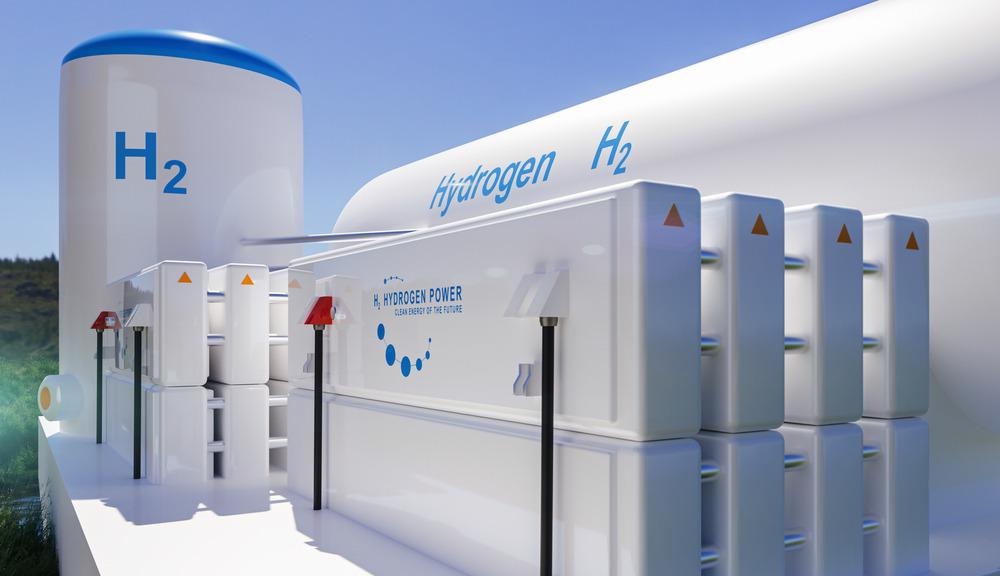This article considers hydrogen energy and its latest uses and advances, from hydrogen production to storage.

Image Credit: Audio und werbung/Shutterstock.com
Hydrogen Energy and its Advantages
Fossil fuels fulfill most of the world's energy demand, but they cause a significant negative impact on the natural ecosystem. The use of renewable energy is a possible solution to minimize environmental degradation. Hydrogen energy has significant potential to accelerate the use of clean and renewable energy, but the technology faces specific challenges. The article discusses the current state and prospects of hydrogen-based technologies.
Hydrogen energy produces no local pollution when used in fuel cells because the byproduct is clean water. Hydrogen has a high specific energy density (three times per unit mass as gasoline-burning) and is manufactured locally. Furthermore, hydrogen production is feasible using a wide variety of substances (water, oil, gas, biofuels, and sewage sludge), and the availability of water permits the synthesis of hydrogen in a relatively sustainable manner.
Hydrogen Production
Hydrogen generation processes such as steam reforming, coal gasification, and water electrolysis are widely employed today, producing carbon byproducts. Hence electrolytic hydrogen production, which uses electricity to extract hydrogen from water while producing no carbon byproducts like CO2, is a recent trend in the industry.
The various methods used for electrolytic hydrogen production are alkaline electrolyzer (AEL), proton exchange membrane electrolyzer (PEMEL), and solid oxide electrolyzer (SOEL).
AEL hydrogen production has advantages such as durability and maturity, but also limitations like low current density and low partial load. PEMEL hydrogen production is compact, practical, and has a higher response rate, but is expensive and has lower durability. SOEL hydrogen production is highly effective, but it is not yet commercialized effectively.
Hydrogen Re-Electrification
The process of generating energy from hydrogen is known as hydrogen re-electrification and is performed in hydrogen combustion engines. However, the thermodynamic efficiency (20%–25%) of hydrogen combustion engines is less than gasoline combustion engines, and CO2 and nitrogen oxides are produced when hydrogen is burned, causing pollution.
Compared to hydrogen combustion engines, fuel cells are a better approach to harness the potential advantages of hydrogen since they transform the chemical energy of hydrogen directly into electrical energy, with only water as a byproduct. Fuel cells are already being used in a range of stationery and transportation applications on a commercial scale, and their efficiency can reach between 60%–80%.
Fuel cell technologies are classified as proton exchange membrane fuel cell (PEMFC), alkaline fuel cell (AFC), solid oxide fuel cell (SOFC), molten carbonate fuel cell (MCFC), and phosphoric acid fuel cell (PAFC). The PEMFC technology has advantages such as fast start-up and has applications in transport and stationary applications, but they use expensive catalysts. The SOFC technology has solid electrolytes, reusable heat, and lower cost, but metal corrosion is a disadvantage.
The AFC technology shows good current response and is primarily used in space applications. MCFC has good conductivity and high current density but can only be applied to large-scale stationary applications and has slow start-up issues. PAFC shows high efficiency with heat co-generation but is limited by low current density and high catalyst cost.
Hydrogen Storage
Hydrogen has a tremendous mass-based energy density (33.33 kWh of energy per kilo), whereas that of petrol and diesel is 12 kWh per kilo. However, a more significant volume is required to store the same quantity of hydrogen. As a result, the development of hydrogen storage technologies is a necessary precondition for developing a hydrogen-powered energy system.
Further Reading: Considering Renewable Hydrogen Production
Compressed gas, underground hydrogen storage systems, liquid hydrogen, and solid storage technologies are recently used methods for hydrogen storage. In recent years, solid-state storage technologies (metal hydrides, complex hydrides, chemical hydrides, and absorbents) have been safer and effective.
Current Status, Challenges, and Future Trends
Hydrogen supply to industrial users is now a big industry worldwide, and the demand for hydrogen has increased significantly over the decades. The manufacturing of hydrogen results in CO2 emissions of roughly 830 million tons per year. The present hydrogen production system using AELs costs between 1000 and 1500 EUR/kW, including installation, whereas PEMELs cost between 2000 and 3000 EUR/kW. In theory, 0.81 L of water is required to create 1 N m3 of hydrogen, but at least 25% more water is required in practice.
The challenges in hydrogen technology such as rare material usage in the fuel cell and electrolyzer systems have caused widespread concern about their high cost, limited supply, and resource scarcity.
The present advances in fuel cell and electrolyzer efficiency and durability are still insufficient (currently 63%–73% whereas the goal is 70%–80%), and they are the major barriers to the successful commercial launch of many hydrogen energy systems. Another difficulty is that fuel cells and electrolysis components may degrade to varying degrees.
The future of hydrogen energy systems lies in utilizing green hydrogen produced using renewable energy and improving the efficiency of fuel cells.
References and Further Reading
Meiling Yue, Hugo Lambert, Elodie Pahon, Robin Roche, Samir Jemei, Daniel Hissel, Hydrogen energy systems: A critical review of technologies, applications, trends and challenges, Renewable and Sustainable Energy Reviews, Volume 146,2021,111180, ISSN 1364-0321, https://www.sciencedirect.com/science/article/pii/S1364032121004688?via%3Dihub
The Future of Hydrogen – Analysis. (n.d.). IEA. https://www.iea.org/reports/the-future-of-hydrogen
Disclaimer: The views expressed here are those of the author expressed in their private capacity and do not necessarily represent the views of AZoM.com Limited T/A AZoNetwork the owner and operator of this website. This disclaimer forms part of the Terms and conditions of use of this website.